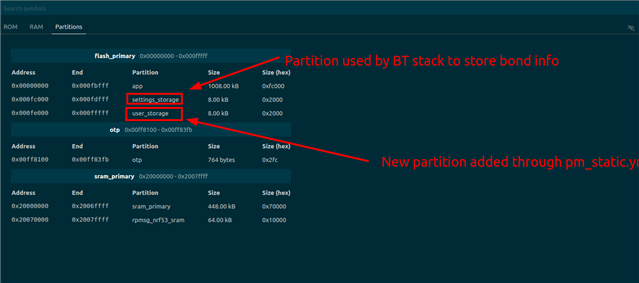Hi
I am trying to get the Zephyr NVS working on an nRF5340_DK board.
I am using the notes here:
And my starting code is based on the example it references:
In nrf5340_cpuapp_common.dts, the flash partitions are defined as follows:
&flash0 {
partitions {
compatible = "fixed-partitions";
#address-cells = <1>;
#size-cells = <1>;
boot_partition: partition@0 {
label = "mcuboot";
reg = <0x00000000 0x00010000>;
};
slot0_partition: partition@10000 {
label = "image-0";
};
slot0_ns_partition: partition@50000 {
label = "image-0-nonsecure";
};
slot1_partition: partition@80000 {
label = "image-1";
};
slot1_ns_partition: partition@c0000 {
label = "image-1-nonsecure";
};
scratch_partition: partition@f0000 {
label = "image-scratch";
reg = <0x000f0000 0xa000>;
};
storage_partition: partition@fa000 {
label = "storage";
reg = <0x000fa000 0x00006000>;
};
};
};
The nRF5340, the Flash page size is 4096 bytes (0x1000). So I decided to define two sectors (I think what should then happen is: when the first sector is full, NVS will then use the second sector. When the second sector is full, it will erase the first sector and use it. I am not sure if we can use just one sector.)
So to reserve some space (two sectors, total size 0x2000) in the storage_partition, I added the following to the app.overlay file:
&flash0 {
partitions {
storage_partition: partition@fa000 {
label = "storage";
reg = <0x000fa000 0x00004000>;
};
user_partition: partition@fe000 {
label = "user_storage";
reg = <0x000fe000 0x00002000>;
};
};
};
Now here’s my code:
uint32_t nvs_var_1;
#define NVS_VAR_1_ID 1
int nvs_data_init() {
struct flash_pages_info info;
const struct device *flash_dev;
int rc = 0;
ssize_t num_bytes;
// See if can use the Flash
flash_dev = DEVICE_DT_GET(FLASH_NODE);
if (!device_is_ready(flash_dev))
{
printk("Flash device %s is not ready\n", flash_dev->name);
return (-1);
}
fs.offset = FLASH_AREA_OFFSET(storage);
printk("fs offset %d\n", fs.offset);
rc = flash_get_page_info_by_offs(flash_dev, fs.offset, &info);
if (rc)
{
printk("Unable to get page info\n");
return (-2);
}
fs.sector_size = info.size;
fs.sector_count = 2U;
printk("size: %d, total: %d\n", info.size, info.size * 2);
rc = nvs_init(&fs, flash_dev->name);
if (rc)
{
printk("Flash Init failed\n");
return (-3);
}
// See if can read the data from the Flash
if (fs.ready) {
printk("ready to read\n");
}
rc = nvs_read(&fs, NVS_VAR_1_ID, &nvs_var_1, sizeof(nvs_var_1));
if (rc > 0)
{ // item was found, show it
printk("Id: %d, nvs_var_1: %d\n", NVS_VAR_1_ID, nvs_var_1);
}
else
{ // item was not found, add it
printk("imme_data_init: nvs_var_1 not found (rc = %d), adding it at id %d\n", rc, NVS_VAR_1_ID);
nvs_var_1 = 99;
if (fs.ready) {
printk("ready to write\n");
}
num_bytes = nvs_write(&fs, NVS_VAR_1_ID, &nvs_var_1, sizeof(nvs_var_1));
printk("imme_data_init: num bytes written: %d\n", num_bytes);
}
return (0);
}
PROBLEM:
When I run this code, the nvs_read() function returns -2 (ENOENT: No such file or directory).
The nvs_write() function always return 4, indicating that 4 bytes have been written.
If I initiate a soft system reset or press the reset button n the board, I get the same results – i.e. each tie the code runs, the nvs_read() function returns -2
So it looks like the code is not defining / accessing the user_partition correctly
Regards
Garrett



